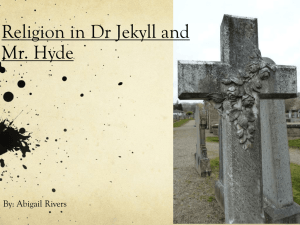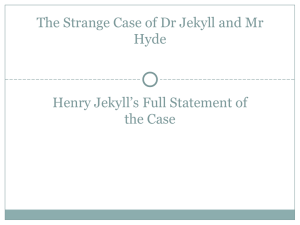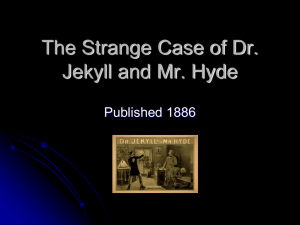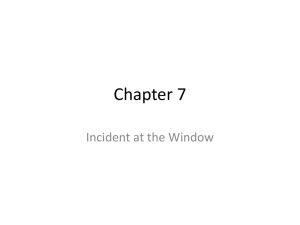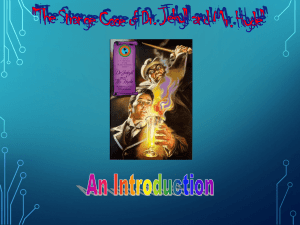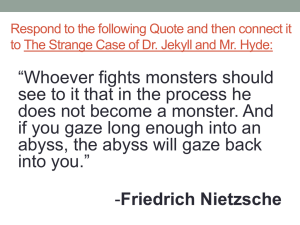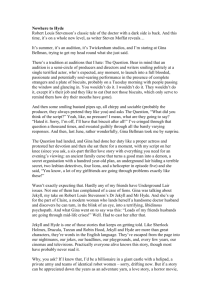Dr Jekyll and Mr Hyde - The Crescent Theatre
advertisement
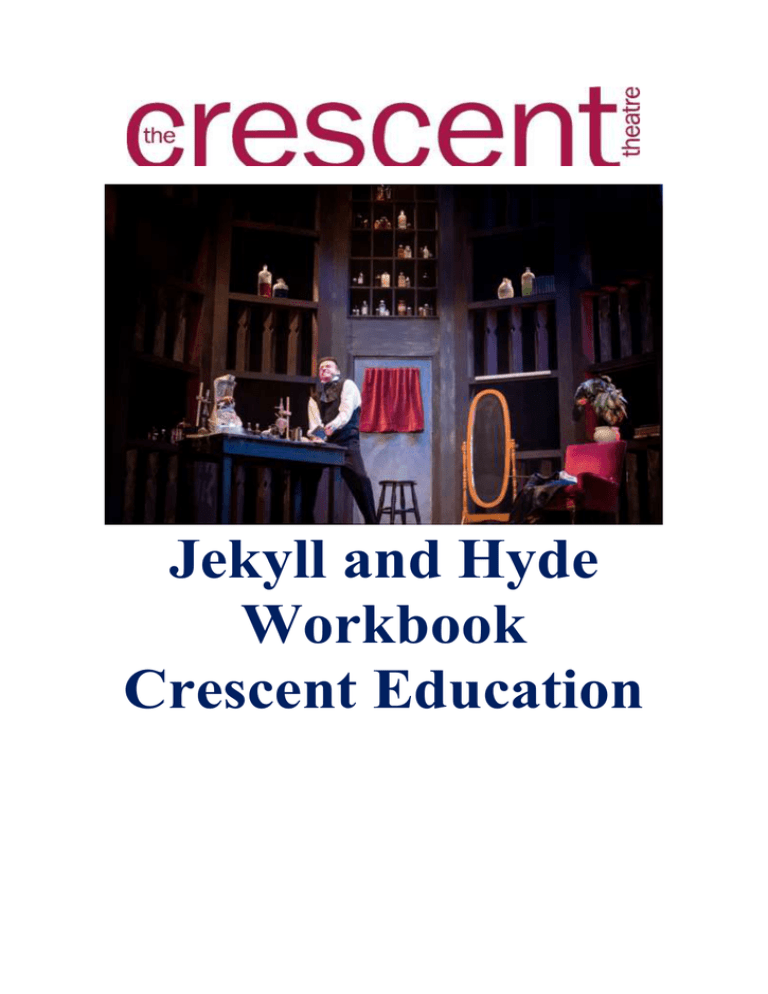
Jekyll and Hyde Workbook Crescent Education To all of our hard-working educationalists who teach a diverse variety of young people: We have produced this education pack as a Word document so that it can be easily changed. As you would all resources, please feel free to adapt anything in this booklet to suit your pupils and students, respecting any copyright where applicable. Remember to share it with colleagues in other establishments too! Should you have any comments, contributions or suggestions, please do contact us at: education@crescent-theatre.co.uk All production stills are courtesy of Graeme Braidwood Photography www.graemebraidwoodphotography.com Introduction Set in the foggy atmosphere of Victorian London, this chilling adaptation of Robert Louis Stevenson’s timeless novel cleverly explores the darker side that lurks within us all. The classic tale relates how Dr Jekyll, fascinated by the duality in his own nature, discovers a drug which isolates the evil side of his character and creates a corrupt alter-ego he calls Mr Hyde. Gradually Hyde gains control as the drug loses its power of restoration. The psychological conflict between good and evil is played out before our eyes - but the fight is not black and white, for as Jekyll is the brake on Hyde's extremities of vice, so is Hyde the check on the excesses of Jekyll's virtue. 1 Advertising a production In order to attract audiences, every theatre creates a poster to advertise its productions. At the Crescent theatre we announce some of our shows up to a year in advance. We therefore initially publish posters that are linked with the play, but not necessarily with the production. This is because, in some cases, the creative team will have only just begun their work. Closer to the performances we then create a poster that is more closely linked to the ideas of the director and designer, and this will usually involve a production photograph of characters from the drama. This is the original design for the poster: 2 This is the second poster: Suggested questions and activities 1. What does the first poster tell you about the drama? 2. What does the second poster tell you about the production? 3. Compare and contrast the two images. 4. Which poster do you prefer? Why? 5. Design your own poster for a production of Jekyll and Hyde that will tell a potential audience about what they play is about. ***** Watch our promotional film for the production: https://www.youtube.com/watch?v=DeLPapxZb-Y 3 The role of the actor Tom, our actor playing both Jekyll and Hyde, was asked a series of questions during rehearsals. Here are his responses: What do you think the actor contributes to the storytelling in a drama? The actor is the flesh and bone; he / she fills out and embodies the character on the stage. It is his / her articulation that supports the narrative. What first attracted you to the role? Initially, the attraction was the challenge of playing two polar opposites within the same person. Having worked at the role now, I have discovered that they are not exactly polar opposites: there is no flipside; Hyde is not the evil to Jekyll’s good. This has been a positive addition to the process, as I have had to look at story in a different light. How did you create your character? As the play does not allow for costume or make-up changes, I had to work hard to find a way to play the two sides of the one person. That means that I can become someone different without even having to leave the stage. The process began with the physical, with each using contrasting body language or, if you will, a different stance: Jekyll is stiff, formal, and upright, like one expects a Victorian to be; Hyde is more simian. Jekyll can be quite prissy, he is very precise, mild mannered and almost hesitant. Both stand in different ways, and their walks differ. Facial expressions also play a role in the depiction of the two: Hyde, for example, sports a lip curling grimace and snarls at times. He speaks with a working class Glaswegian dialect, whereas Jekyll speaks RP. What has been the biggest challenge? The greatest obstacle has been a technical one: instead of representing two completely different characters onstage, I have discovered that it is more rewarding to play a bit of the one character in the other so that neither are simply painted in black and white. Then there is the allegory of the undercurrent of repression in general. How long has it taken to get to know the character and learn the role? We meet three times a week in our rehearsal room for about six weeks before we get to finish the rehearsal process on the main stage, but of course I have put a lot of thought into the character at home. What are you hoping audiences will take away from the show with them? Our production will give audiences a glimpse beyond the façade of ‘mad scientist’. When they see something that they can identify with, then we have hooked them in and we can tell the story. It is the human story that will hold their attention and will engage them. 5 The designer’s contribution What is the designer’s job on a stage production? I am responsible for the visual realisation of the playwright’s intentions. This, of course, ‘a version’, as each designer will interpret the text in a different way. What is important is that it that any design supports the storytelling in a dramatic way. What attracted you to the piece in particular? For this particular piece there were a combination of factors. Like Shakespeare’s works, the story is timeless, and timeless pieces offer great potential for being reinvented for a contemporary audience. I had recently been to a design convention in Prague, a city whose history partly resonated with Victorian Britain. There is an alchemy museum there that depicts the seedy, underground medicine scene really well, with its ‘back rooms’ in apothecary stores, where all sorts of ‘not-so-legitimate’ work was undertaken. It was evident that my experiences here would influence the atmosphere of the piece. I had also worked with director before, so we already shared a common language. Can you explain your process somewhat? Edgar knows how theatre works, so his writing supports the designer (which doesn’t always happen!) I read and re-read the play, then create a breakdown of the 23 scenes (and therefore 22 changes of location/time). This incudes things like who is onstage in each scene, and what props and furniture are needed. In doing this, images start to come to come to mind, and it is from these images that my ideas begin to develop. This links in with research that I have done about the period in which the play is set. I then begin to sketch my ideas, and then build models, sharing them with our construction team as well as with the director. Being an actual presence in rehearsals is useful, as it helps consolidate ideas. The practicalities of design dictate much of my work. I The scenes need to flow into one another seamlessly, so I have to figure out how the scene changes will work, map out sizes and dimensions, and source whatever will be needed. I am fortunate in that the Crescent has had a presence in Birmingham for a very long time, and the theatre possesses its own extensive collection of sets, furniture, props and costumes. Faye’s original model of the set 6 Model of Jekyll’s door Can you offer an insight into the set for this production in particular? Jekyll’s hallway and his laboratory co-exist in stage, so we have to ensure that the audience comprehends in which location the action is taking place. One of the visuals that I was always keen to use was that of the 19th century dissection theatre, where many advancements in medicine were made. I am not a designer who necessarily works in a naturalistic way. I particularly enjoy working metaphorically: picking out themes and symbols and creating visual reminders of them. There is one solitary armchair on stage, and I love the metaphorical potential that this offers as well as a practical solution of offering somewhere to sit. Whilst in Prague I photographed hundreds of doors, and doors have endless symbolic and practical uses. A closed door, for example, conceals something, and this something has infinite variations until opened. Doors are mentioned regularly in the dialogue, and in our production ‘her’ doors are white, airy, and they open out; ‘his’ doors are heavy and remain resolutely closed for much of the action. ground plan of the stage including to scale drawings of the set Watch a short video of the set being constructed: https://www.youtube.com/watch?v=Y9bbF6jKceo&feature=youtu.be&app=desktop 7 The director’s role What does your job, as the director, entail? My role is to comprehend what the ‘bigger picture’ will look like. I am there to fashion this picture, with the input of the actors and the designer. Actors need a director, as they are on stage and unable to see how the piece looks from an audience perspective. They, quite rightly, are focused on their job of creating a character and I am there to support them; I will be a soundboard that supports their journey during rehearsals. Then, when we move onto the stage it is me who has to ensure that all of the elements come together (actors’ performances, sets, costumes, make-up, sound, lighting) as a coherent story. What made you wish to direct this piece in particular? I am a sci-fi fan, especially early sci-fi, and I particularly love the Victorian period in history; this was an era of ‘flaky science’, one of theories and practices of chemistry and neurology that have since been proven to not actually exist. It was Jekyll’s father who began the experiments that his son continued. There is a suggestion in the script that whatever is happening in his own body can be passed down the generations through the family bloodline. Jekyll, for example, attacks his own sister, which is very out of character. The play reflects a 21st century way of looking at this 19th century theory of the ‘taint in the family line’. What are the main differences between the novella and David Edgar’s stage adaptation? This tale has been dramatized many, many times (including three musical versions). It is a very visceral story that begs to be told, and each adaptation has changed from the original story. In this version, Edgar manages to pull it out to a wider focus. The original has no female characters; most adaptations introduce a female. Edgar takes this further: he gives Jekyll a sister. This supports explaining the relevance of the bloodline. I consider this to be a stroke of genius. She has two children, and their relevance can be greatly expanded to represent the two sides of an individual. Most teenagers go through the phase of ‘mood swings’, with the adult having to parent two different children for a while: the remnants of the angelic, playful child, and the volatile teenager whose sudden and violent mood changes can upset the delicate balance in any household. What have been the particular challenges in bringing the piece to the stage? The biggest challenge was always going to be working with one actor who has to create the two sides of one character. Some of the techniques that we come up with are strength of eyesight (one wears glasses, the other doesn’t – quickly achieved on stage, which helps with the pace of the drama), the character’s height (our actor Tom changes his posture to represent each of the two), and what we have come to call ‘handidness’ (one is left, the other right handed, so the actor has had to work on being ambidextrous). The play is a series of 23 relatively short scenes, so from the beginning we had to find a way of staging the piece fluidly, so that the audience can easily see a change of time of location without us having to spend a lot of stage time moving things. 8 Suggestions for extension activities 1. 2. 3. 4. 5. 6. 7. 8. 9. Compare the language between a scene from the novella and one from the play. Get the pupils to write their own questions about the interviews with the actor, designer and director. When the maid gets pregnant, she gets dismissed. Discuss this in the Victorian context, thinking about their values and morality. Some schools teach Victorian medicine in year 9. Get pupils to make cross-curricular links with what they have learned about 19th century medical advances. Watch the opening of James Whales’ Frankenstein. The Doctor and his assistant are forced to rob graves in order to have access to the bodies the doctor needs for the his experiments. Discuss how the (sometimes) illegal work that doctors and scientists undertook in the 19th Century has led to a higher mortality rate in the 21st Century. Watch carefully selected excerpts from ‘The Elephant Man’. Several scenes show the inside of the hospitals and dissection theatres with great historical clarity. Hyde is like an animal, but unlike John Merrick, he chooses to play with his own destiny. The plight of the ‘Elephant Man’ is not of his own choosing, but both are influenced by Victorian values and are a great starting point for a discursive essay. Come at the story from an RE teacher’s perspective. Ethics play a great part in the story. Get pupils to research, prepare and then debate evolution v religion. Compare and contrast the advantages and disadvantages of having two actors play the role of Jekyll/Hyde. Pupils can select any moment in the drama or novella and write their own dramatic monologue for possible use in their own speaking and listening examination for English language. 11 Crescent Education The Crescent Theatre education department is committed to establishing, nurturing and developing relationships with education establishments throughout Birmingham, the West Midlands and beyond. In doing this, we aim to foster cultural awareness in young people and encourage them to actively engage with live theatre. We have ongoing relationships of mutual trust with schools, colleges and universities that are of benefit to both parties, as we firmly believe that theatre visits should be an integral and vital part of their academic year. The education ticket price is currently (February 2016) set at £5 (£8 at weekends) per head, a figure that has remained constant for several years now. This means that, from a financial point of view, our productions are more accessible than any other theatre in Birmingham. We also actively encourage schools and colleges to use the pupil premium to allow pupils for whom £5 remains a barrier to accessing live theatre. In addition to this, we are able to offer theatre tours and in-house bespoke workshops, as well as opportunities to meet cast members, designer and / or director. For up to date information on upcoming productions and education opportunities that reflect the needs of the current curriculums and examination syllabi, please access the education page via our website: www.crescent-theatre.co.uk
